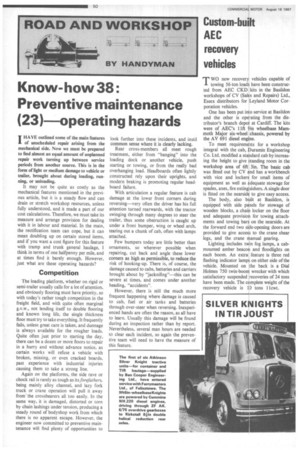Know-how 38: Preventive maintenance (23)--operating hazards
Page 52

If you've noticed an error in this article please click here to report it so we can fix it.
LHAVE outlined some of the main features 11of unscheduled repair arising from the mechanical side. Now we must be prepared to find almost an equal amount of unplanned repair work turning up between service periods from another source. This is in the form of light or medium damage to vehicle or trailer, brought about during loading, running, or unloading.
It may not be quite as costly as the mechanical features mentioned in the previous article, but it is a steady flow and can drain or stretch workshop resources, unless fully understood, and it made a part of our cost calculations. Therefore, we must take its measure and arrange provision for dealing with it in labour and material. In the main, the rectification team can cope, but it can mean doubling up on certain stored items, and if you want a cost figure for this feature with tramp and trunk general haulage, I think in terms of one halfpenny per mile, and at times find it barely enough. However, just what are these operating hazards?
Competition
The loading platform, whether on rigid or semi-trailer usually calls for a lot of attention. and obviously flooring must have priority, so with today's rather tough competition in the freight field, and with quite often marginal g.v.w., not lending itself to double flooring and known long life, the single thickness floor must try to take everything. It frequently fails, unless great care is taken, and dunnage is always available for the rougher loads. Quite often just prior to starting the day, there can be a dozen or more floors to repair in a hurry and without advance notice, as certain works will refuse a vehicle with broken, missing, or even cracked boards, past experience with industrial injuries causing them to take a strong line.
Again on the platforms, the side rave or chock rail is rarely as tough as its forefathers, being mainly alloy channel, and lazy fork truck or crane operation will pull it away from' the crossbearers all too easily. In the same way, it is damaged, distorted or torn by chain lashings under tension, producing a steady round of body shop work from which there is no apparent escape. However, the engineer now committed to preventive maintenance will find plenty of opportunities to
look further into these incidents, and instil common sense where it is clearly lacking.
Rear cross-members all meet rough treatment, either from -banging" into the loading dock or another vehicle, push starting or towing, or from the really bad overhanging load. Headboards often lightly constructed rely upon their uprights, and modern braking is promoting regular headboard failure.
With articulation a regular feature is cab damage at the lower front corners during reversing—very often the driver has his full attention turned rearwards, with the tractor swinging through many degrees to steer the trailer, thus some obstruction is caught up under a front bumper, wing or wheel arch, tearing out a chunk of cab, often with lamps attached.
Few bumpers today are little better than ornaments, so wherever possible when repairing, cut back and angle these lower corners as high as permissible, to reduce the risk of hooking-up. There is, of course, the damage caused to cabs, batteries and carriers brought about by "jacknifing"—this can be severe at times, and comes under another heading, "accidents".
However, there is still the much more frequent happening where damage is caused to cab, fuel or air tanks and batteries through over-steer when reversing. Inexperienced hands are often the reason, as all have to learn. Usually this damage will be found during an inspection rather than by report. Nevertheless, several man hours are needed to clear each incident, so again the preventive team will need to have the measure of this feature.




































































































































